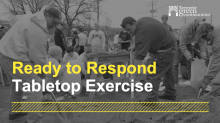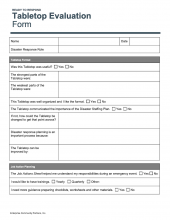Continually practicing and refining your Disaster Staffing Plan is essential to ensuring its effectiveness. As your organization changes, and potential threats to your buildings and residents change, be sure to perform these important tasks to keep your plan up-to-date.
Tabletop Facilitator Guide
This guide will help you prepare for, hold and follow-up your organization’s Tabletop Exercise.
What is a Tabletop?
A Tabletop is a training exercise which lets an organization test its Disaster Staffing Plan and practice effective communication among the Disaster Response Roles.
Key Facilitator Goals
- Make sure discussions stay on track and all attendees participate.
- Promote open discussion by emphasizing that participants should feel free to make mistakes.
- Carefully observe breakout groups to identify strengths and weaknesses.
- Be flexible.
Materials to Review
- Ready to Respond: An Overview of the Disaster Staffing Toolkit video
- Tabletop Exercise Presentation
- Tabletop Evaluation Form
- After Action Report Guide
Before the Tabletop Exercise
Plan the logistics of the Tabletop Exercise including date, time, location and agenda and send invitations to the appropriate staff members and residents.
Customize the Tabletop Exercise Presentation
- The disaster scenario included in the presentation is a hurricane. You may want to choose a scenario more likely to occur in your area.
- Fill in the appropriate staff names in the Staffing Chart.
- Modify the agenda to fit your schedule.
Instruct all participants to
- Confirm their assigned Disaster Response Role.
- Watch the video Ready to Respond: An Overview of the Disaster Staffing Toolkit.
- Prepare Job Action Packets to bring to the Tabletop.
During the Tabletop
- Present the information in the Tabletop Exercise Presentation including your Staffing Chart, agenda, Incident Command System concepts and tools.
- Introduce the disaster scenario.
- At the end of each Operational Period in the scenario, instruct participants to break into groups based on their Disaster Response Roles. Ask the following questions, giving enough time for productive discussion:
- What key decisions need to be made?
- What are your tasks during the operational period?
- How are you working and communicating with others?
- After the presentation concludes, lead an open discussion, asking the following questions:
- What went well?
- What didn’t go well?
- What areas can be improved?
- Distribute Tabletop Evaluation Forms and encourage participants to be as detailed as possible in filling them out.
- Collect Tabletop Evaluation Forms and thank participants for attending.
After the Tabletop
- Write the After Action Report which provides an explanation of what occurred during the Tabletop Exercise. See the After Action Report Guide.
- Use the information gathered in the Tabletop Evaluation Forms and your personal observations to complete the After Action Report.

After Action Report Guide
An After Action Report (AAR) gathers information about your organization’s response to what happened during a Tabletop Exercise or a disaster. It also evaluates staff performance and the overall effectiveness of your Disaster Staffing Plan.
An AAR should be written by the Emergency Preparedness Coordinator and Incident Commander after every Tabletop Exercise or disaster.
These questions and items should be included in the AAR. Customize the report to the needs and experiences of your organization.
1. Summary
- Name of the organization.
- Name of author of the report.
- Date of Tabletop Exercise or disaster.
- Location of Tabletop Exercise or disaster.
- Participants:
- How many staff members took part?
- What are their usual roles within the organization?
- Which roles did they fill during the Tabletop Exercise or disaster?
- What did you hope to accomplish and learn?
- Did you accomplish what you wanted to? If not, why?
2. Planning Phase Overview
- Has your organization experienced an emergency before?
- Did your organization have an emergency plan? If so, describe it.
- Why did your organization decide to take on this work?
- When did your Planning Phase begin?
- Did staff customize their Job Action Sheets during the Planning Phase?
- Did staff adequately prepare checklists, worksheets and other materials during the Planning Phase?
3. Evaluation and Next Steps
If you prepare the AAR after a Tabletop Exercise, compile results from the Tabletop Evaluation Form to complete this section.
- What were the strongest parts of the Tabletop Exercise or disaster response?
- What were the weakest?
- What do you hope to improve on?
- How effective were the Job Actions Sheets?
- How effective were the checklists, worksheets and other materials?
- How will you improve and update your current Disaster Staffing Plan based on the results of the Tabletop Exercise or disaster? (See “Improvement Plan” below).
Improvement Plan
A detailed Improvement Plan will document planning gaps or challenges in preparedness which come to light during Tabletop Exercises or disasters. This information is also gathered in After Action Reports and Tabletop Evaluations. Here is a checklist to include in your Improvement Plan. Customize this plan to the needs of your organization.
Specific Gaps and Challenges
- Describe the details of the challenge.
- Which role or roles are involved?
- Which operational period or periods are involved?
- Additional information.
Recommended Solutions
- List and describe potential solutions.
- What changes need to be made to the overall plan?
- What changes need to be made to specific operational periods?
- Which role or roles are involved?
Corrective Actions
- What actions should each role take to fulfill the recommendations?
- Who will follow up on this?
Follow-Up
- Draw up a timeline to complete corrective actions.
- Draw up a timeline and methods to communicate solutions to senior leadership.
- Draw up a timeline and methods to communicate solutions for each role’s shortcomings.
- Plan to test corrective actions during additional Tabletop Exercises.


